介词in.on.at表示时间的用法区别
- 格式:doc
- 大小:26.00 KB
- 文档页数:1

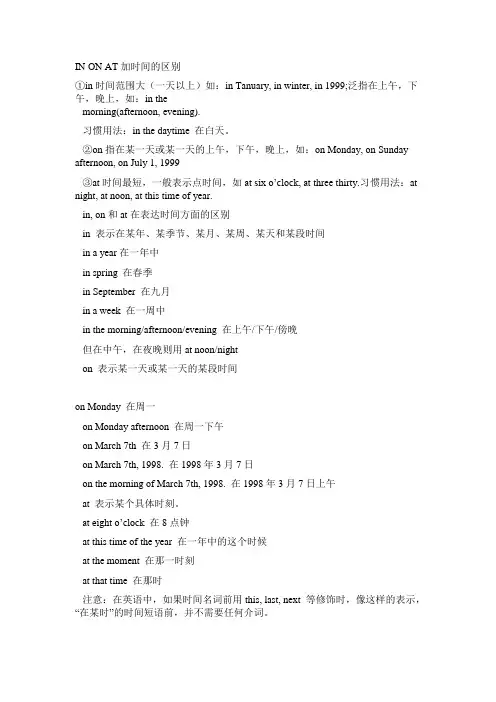
IN ON AT加时间的区别①in时间范围大(一天以上)如:in Tanuary, in winter, in 1999;泛指在上午,下午,晚上,如:in themorning(afternoon, evening).习惯用法:in the daytime 在白天。
②on指在某一天或某一天的上午,下午,晚上,如:on Monday, on Sunday afternoon, on July 1, 1999③at时间最短,一般表示点时间,如at six o’clock, at three thirty.习惯用法:at night, at noon, at this time of year.in, on和at在表达时间方面的区别in 表示在某年、某季节、某月、某周、某天和某段时间in a year在一年中in spring 在春季in September 在九月in a week 在一周中in the morning/afternoon/evening 在上午/下午/傍晚但在中午,在夜晚则用at noon/nighton 表示某一天或某一天的某段时间on Monday 在周一on Monday afternoon 在周一下午on March 7th 在3月7日on March 7th, 1998. 在1998年3月7日on the morning of March 7th, 1998. 在1998年3月7日上午at 表示某个具体时刻。
at eight o’clock 在8点钟at this time of the year 在一年中的这个时候at the moment 在那一时刻at that time 在那时注意:在英语中,如果时间名词前用this, last, next 等修饰时,像这样的表示,“在某时”的时间短语前,并不需要任何介词。
例如:last month, last week, this year, this week, next year, the next day, thenext year等。
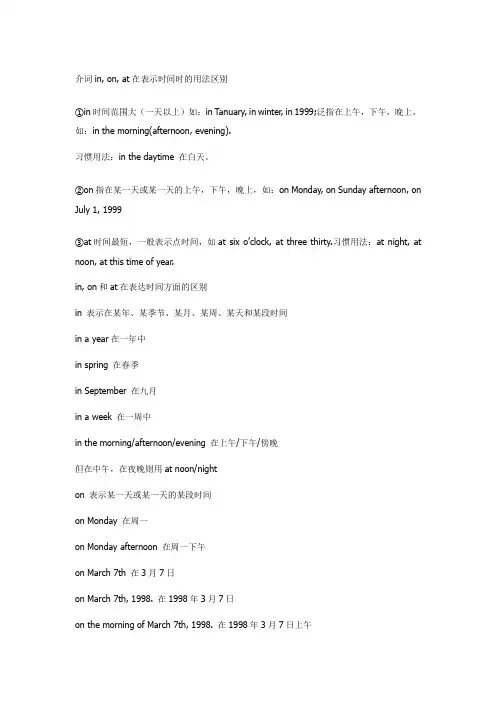
介词in, on, at在表示时间时的用法区别①in时间范围大(一天以上)如:in Tanuary, in winter, in 1999;泛指在上午,下午,晚上,如:in the morning(afternoon, evening).习惯用法:in the daytime 在白天。
②on指在某一天或某一天的上午,下午,晚上,如:on Monday, on Sunday afternoon, on July 1, 1999③at时间最短,一般表示点时间,如at six o’clock, at three thirty.习惯用法:at night, at noon, at this time of year.in, on和at在表达时间方面的区别in 表示在某年、某季节、某月、某周、某天和某段时间in a year在一年中in spring 在春季in September 在九月in a week 在一周中in the morning/afternoon/evening 在上午/下午/傍晚但在中午,在夜晚则用at noon/nighton 表示某一天或某一天的某段时间on Monday 在周一on Monday afternoon 在周一下午on March 7th 在3月7日on March 7th, 1998. 在1998年3月7日on the morning of March 7th, 1998. 在1998年3月7日上午at 表示某个具体时刻。
at eight o’clock 在8点钟at this time of the year 在一年中的这个时候at the moment 在那一时刻at that time 在那时注意:在英语中,如果时间名词前用this, last, next 等修饰时,像这样的表示,“在某时”的时间短语前,并不需要任何介词。
例如:last month, last week, this year, this week, next year, the next day, the next year 等。
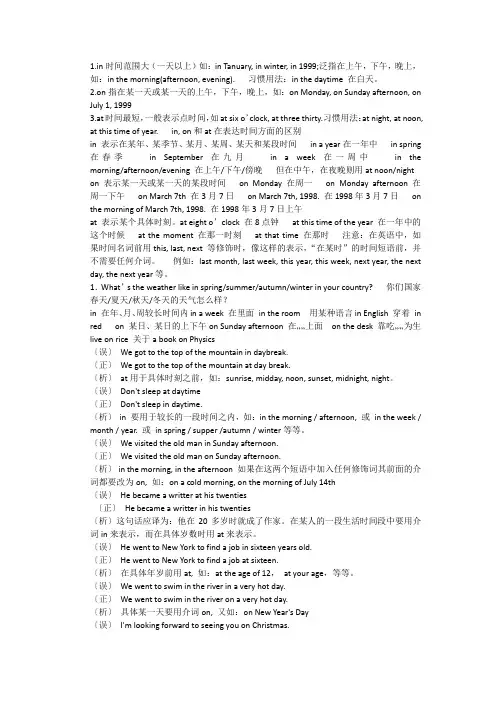
1.in时间范围大(一天以上)如:in Tanuary, in winter, in 1999;泛指在上午,下午,晚上,如:in the morning(afternoon, evening). 习惯用法:in the daytime 在白天。
2.on指在某一天或某一天的上午,下午,晚上,如:on Monday, on Sunday afternoon, on July 1, 19993.at时间最短,一般表示点时间,如at six o’clock, at three thirty.习惯用法:at night, at noon, at this time of year. in, on和at在表达时间方面的区别in 表示在某年、某季节、某月、某周、某天和某段时间in a year在一年中in spring 在春季in September 在九月in a week 在一周中in the morning/afternoon/evening 在上午/下午/傍晚但在中午,在夜晚则用at noon/night on 表示某一天或某一天的某段时间on Monday 在周一on Monday afternoon 在周一下午on March 7th 在3月7日on March 7th, 1998. 在1998年3月7日on the morning of March 7th, 1998. 在1998年3月7日上午at 表示某个具体时刻。
at eight o’clock 在8点钟at this time of the year 在一年中的这个时候at the moment 在那一时刻at that time 在那时注意:在英语中,如果时间名词前用this, last, next 等修饰时,像这样的表示,“在某时”的时间短语前,并不需要任何介词。
例如:last month, last week, this year, this week, next year, the next day, the next year等。

介词in, on, at在表示时间时的用法区别①in时间范围大(一天以上)如:in Tanuary, in winter, in 1999;泛指在上午,下午,晚上,如:in the morning(afternoon, evening).习惯用法:in the daytime 在白天。
②on指在某一天或某一天的上午,下午,晚上,如:on Monday, on Sunday afternoon, on July 1, 1999③at时间最短,一般表示点时间,如at six o’clock, at three thirty.习惯用法:at night, at noon, at this time of year.in, on和at在表达时间方面的区别in 表示在某年、某季节、某月、某周、某天和某段时间in a year在一年中in spring 在春季in September 在九月in a week 在一周中in the morning/afternoon/evening 在上午/下午/傍晚但在中午,在夜晚则用at noon/nighton 表示某一天或某一天的某段时间on Monday 在周一on Monday afternoon 在周一下午on March 7th 在3月7日on March 7th, 1998. 在1998年3月7日on the morning of March 7th, 1998. 在1998年3月7日上午at 表示某个具体时刻。
at eight o’clock 在8点钟at this time of the year 在一年中的这个时候at the moment 在那一时刻at that time 在那时注意:在英语中,如果时间名词前用this, last, next 等修饰时,像这样的表示,“在某时”的时间短语前,并不需要任何介词。
例如:last month, last week, this year, this week, next year, the next day, the next year等。
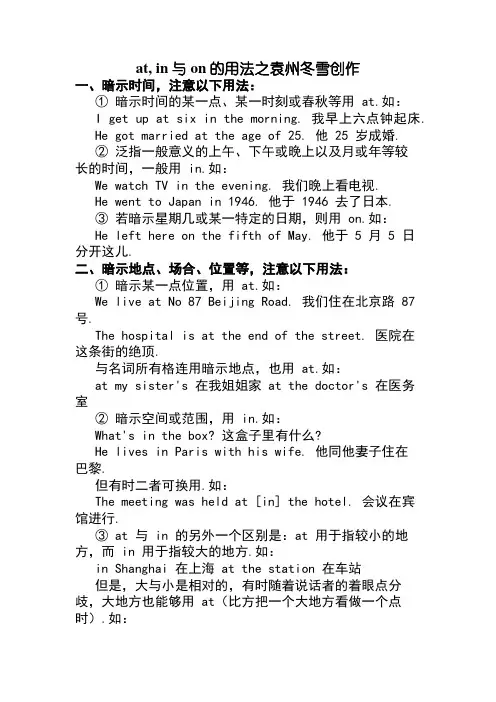
at, in与on的用法之袁州冬雪创作一、暗示时间,注意以下用法:①暗示时间的某一点、某一时刻或春秋等用 at.如:I get up at six in the morning. 我早上六点钟起床.He got married at the age of 25. 他 25 岁成婚.②泛指一般意义的上午、下午或晚上以及月或年等较长的时间,一般用 in.如:We watch TV in the evening. 我们晚上看电视.He went to Japan in 1946. 他于 1946 去了日本.③若暗示星期几或某一特定的日期,则用 on.如:He left here on the fifth of May. 他于 5 月 5 日分开这儿.二、暗示地点、场合、位置等,注意以下用法:①暗示某一点位置,用 at.如:We live at No 87 Beijing Road. 我们住在北京路 87 号.The hospital is at the end of the street. 医院在这条街的绝顶.与名词所有格连用暗示地点,也用 at.如:at my sister's 在我姐姐家 at the doctor's 在医务室②暗示空间或范围,用 in.如:What's in the box? 这盒子里有什么?He lives in Paris with his wife. 他同他妻子住在巴黎.但有时二者可换用.如:The meeting was held at [in] the hotel. 会议在宾馆进行.③ at 与 in 的另外一个区别是:at 用于指较小的地方,而 in 用于指较大的地方.如:in Shanghai 在上海 at the station 在车站但是,大与小是相对的,有时随着说话者的着眼点分歧,大地方也能够用 at(比方把一个大地方看做一个点时).如:Our plane refuelled at London. 我们的飞机在伦敦加油.We stopped for an hour at Moscow on our way to Paris. 我们在去巴黎的途中在莫斯科停了 1 个小时.④介词 on 用于地点,主要指在某物的概况.如:What's on the table? 桌上有什么?There's a wallet lying on the ground. 地上有个钱包.【注】在少数搭配中,也用介词 on.如:He works on a farm. 他在农场工作.三、在某些搭配中,三者的区别与英国英语和美国英语有关:in the street (英) / on the street (美) 在街上in the road (英) / on the road (美) 在路上in the team (英) / on the team (美) 在这个队at the weekend (英) / on the weekend (美) 在周末at weekends (英) / on weekends (美) 在周末四、有时三者的不同与搭配习惯和用法有关:in bed 在床上on the bed 在床上in the tree (多指树外之物) 在树上on the tree (多指树自己之物) 在树上at, in与on的区别一、in,on在方位名词前的区别1. in暗示A地在B地范围之内.如: Taiwan is in the southeast of China.2. on暗示A地与B地交界、毗邻.如: North Korea is on the east of China.二、at, in, on在暗示时间上的区别1. at指时间暗示:(1)时间的一点、时刻等.如:They came home at sunrise (at noon, at midnight, at ten o’clock, at daybreak, at dawn).(2)较短暂的一段时间.可指某个节日或被认为是一年中标记大事的日子.如:He went home at Christmas (at New Year, at the Spring Festival, at night).2. in指时间暗示:(1)在某个较长的时间(如世纪、朝代、年、月、季节以及泛指的上午、下午或傍晚等)内.如:in 2004, in March, in spring, in the morning, in the evening, etc(2)在一段时间之后.一般情况下,用于将来时,谓语动词为瞬间动词,意为“在……以后”.如:He will arrive in two hours.谓语动词为延续性动词时,in意为“在……以内”.如:These products will be produced in a month.注意:after用于将来时间也指一段时间之后,但其后的时间是“一点”,而不是“一段”.如:He will arrive after two o’clock.3. on指时间暗示:(1)详细的时日和一个特定的时间,如某日、某节日、星期几等.如:On Christmas Day(On May 4th), there will be a celebration.(2)在某个特定的早晨、下午或晚上.如:He arrived at 10 o’clock on the night of the 5th. (3)准时,按时.如:If the train should be on time, I should reach home before dark.三、at, in和on暗示地点时的区别1. at暗示地点:(1)用于指较小的地方.如: I shall wait for you at the station.(2)用于门商标码前.如: He lives at 115 Zhongshan Road.2. in暗示地点:(1)用于指较大的地方.如:He lives in Shanghai. (2)虽然是很小的地方,如果说话人住在那边,也可用in.商店、学校、机关等,若看做一个地点(point)用at,若看做一个场合(place)用in.如:I met him at the post-office.I’m now working in the post-office.3. on暗示地点,一般指与面或线接触,意为“在……上;在……旁”.如:The picture was hanging on the wall.New York is on the Hudson River.。
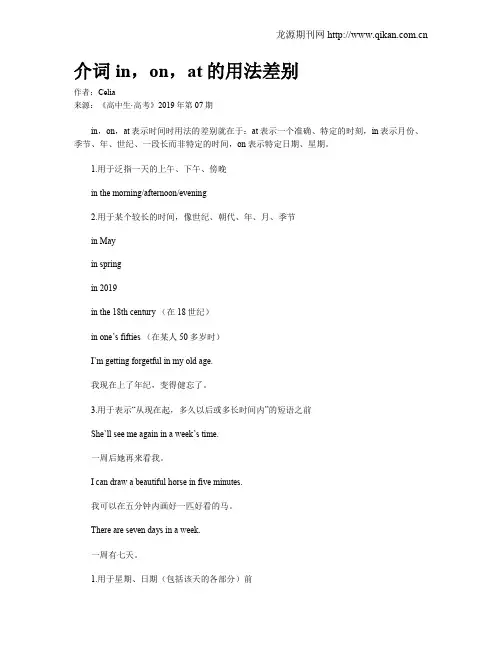
介词in,on,at的用法差别作者:Celia来源:《高中生·高考》2019年第07期in,on,at表示时间时用法的差别就在于:at表示一个准确、特定的时刻,in表示月份、季节、年、世纪、一段长而非特定的时间,on表示特定日期、星期。
1.用于泛指一天的上午、下午、傍晚in the morning/afternoon/evening2.用于某个较长的时间,像世纪、朝代、年、月、季节in Mayin springin 2019in the 18th century (在18世纪)in one’s fifties (在某人50多岁时)I’m getting forgetful in my old age.我现在上了年纪,变得健忘了。
3.用于表示“从现在起,多久以后或多长时间内”的短语之前She’ll see me again in a week’s time.一周后她再来看我。
I can draw a beautiful horse in five minutes.我可以在五分钟内画好一匹好看的马。
There are seven days in a week.一周有七天。
1.用于星期、日期(包括该天的各部分)前on Sundays/weekdays“在周末”既可以说at weekends,也可以说on weekends。
I often go fishing on/ at weekends.我经常在周末去钓鱼。
2.用于morning/afternoon/evening/night/day前此时这类名词前多有修饰语或带有of等引起的后置修饰语,指具体的或不具体的某一日。
on Sundays/weekdayson Monday morning/afternoon/eveningOn May the first/the first of May(在五月一日)On the evening of May the first(在五月一日的晚上)I’m flying home on Sunday afternoon.我星期天下午乘飞机回家。
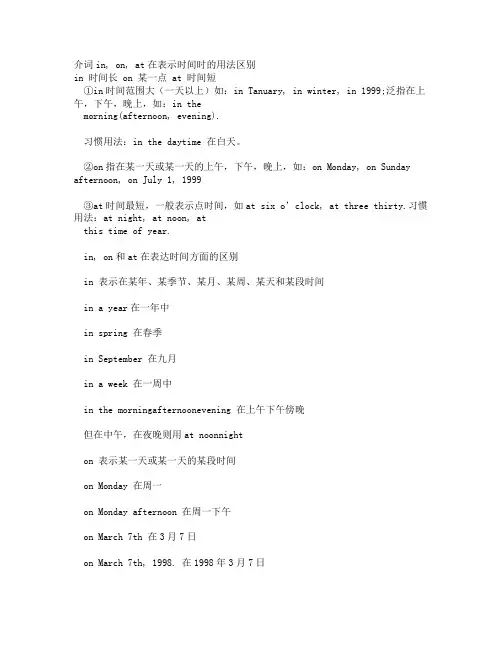
介词in, on, at在表示时间时的用法区别in 时间长 on 某一点 at 时间短①in时间范围大(一天以上)如:in Tanuary, in winter, in 1999;泛指在上午,下午,晚上,如:in themorning(afternoon, evening).习惯用法:in the daytime 在白天。
②on指在某一天或某一天的上午,下午,晚上,如:on Monday, on Sunday afternoon, on July 1, 1999③at时间最短,一般表示点时间,如at six o’clock, at three thirty.习惯用法:at night, at noon, atthis time of year.in, on和at在表达时间方面的区别in 表示在某年、某季节、某月、某周、某天和某段时间in a year在一年中in spring 在春季in September 在九月in a week 在一周中in the morningafternoonevening 在上午下午傍晚但在中午,在夜晚则用at noonnighton 表示某一天或某一天的某段时间on Monday 在周一on Monday afternoon 在周一下午on March 7th 在3月7日on March 7th, 1998. 在1998年3月7日on the morning of March 7th, 1998. 在1998年3月7日上午at 表示某个具体时刻。
at eight o’clock 在8点钟at this time of the year 在一年中的这个时候at the moment 在那一时刻at that time 在那时注意:在英语中,如果时间名词前用this, last, next 等修饰时,像这样的表示,“在某时”的时间短语前,并不需要任何介词。
例如:last month, last week, this year, this week, next year, the next day, thenext year等。
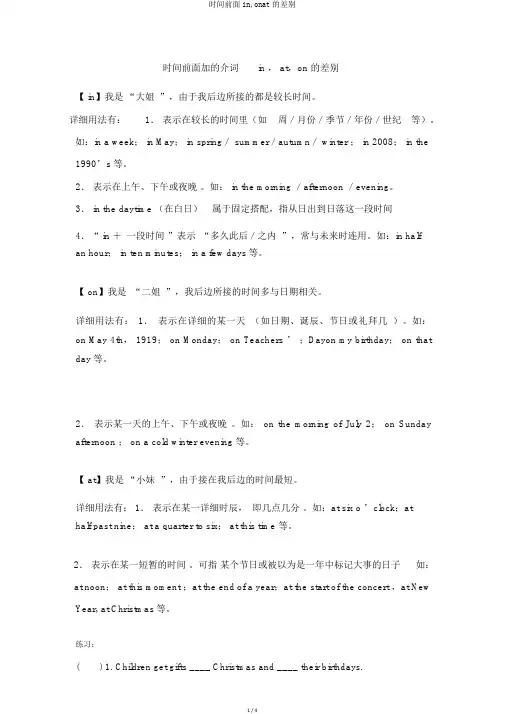
时间前面加的介词in , at,on 的差别【 in】我是“大姐”,由于我后边所接的都是较长时间。
详细用法有:1.表示在较长的时间里(如周/月份/季节/年份/世纪等)。
如:in a week; in May; in spring/ summer/autumn/ winter ; in 2008; in the 1990’s等。
2.表示在上午、下午或夜晚。
如: in the morning /afternoon /evening。
3. in the daytime (在白日)属于固定搭配,指从日出到日落这一段时间4.“ in +一段时间”表示“多久此后/之内”,常与未来时连用。
如:in halfan hour; in ten minutes; in a few days等。
【 on】我是“二姐”,我后边所接的时间多与日期相关。
详细用法有:1.表示在详细的某一天(如日期、诞辰、节日或礼拜几)。
如:on May 4th, 1919; on Monday; on Teachers ’;Dayon my birthday; on that day 等。
2.表示某一天的上午、下午或夜晚。
如:on the morning of July 2;on Sunday afternoon ; on a cold winter evening 等。
【 at】我是“小妹”,由于接在我后边的时间最短。
详细用法有: 1.表示在某一详细时辰,即几点几分。
如:at six o ’clock;athalf past nine; at a quarter to six; at this time 等。
2.表示在某一短暂的时间。
可指某个节日或被以为是一年中标记大事的日子如:at noon; at this moment ;at the end of a year;at the start of the concert ,at New Year, at Christmas等。
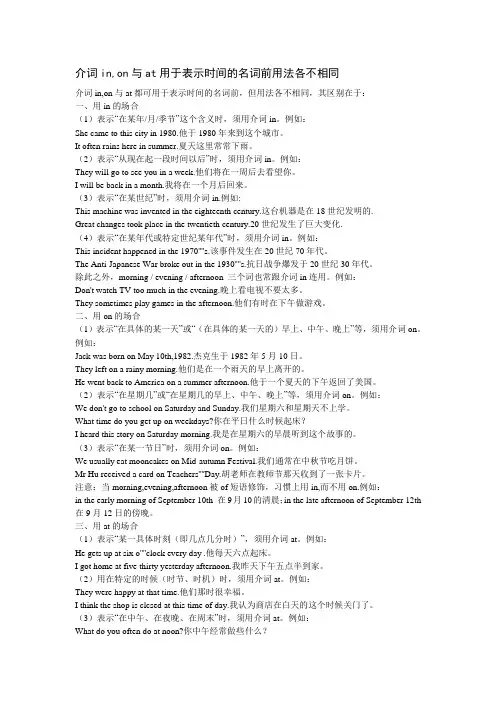
介词in,on与at用于表示时间的名词前用法各不相同介词in,on与at都可用于表示时间的名词前,但用法各不相同,其区别在于:一、用in的场合(1)表示“在某年/月/季节”这个含义时,须用介词in。
例如:She came to this city in 1980.他于1980年来到这个城市。
It often rains here in summer.夏天这里常常下雨。
(2)表示“从现在起一段时间以后”时,须用介词in。
例如:They will go to see you in a week.他们将在一周后去看望你。
I will be back in a month.我将在一个月后回来。
(3)表示“在某世纪”时,须用介词in.例如:This machine was invented in the eighteenth century.这台机器是在18世纪发明的.Great changes took place in the twentieth century.20世纪发生了巨大变化.(4)表示“在某年代或特定世纪某年代”时,须用介词in。
例如:This incident happened in the 1970''''s.该事件发生在20世纪70年代。
The Anti-Japanese War broke out in the 1930''''s.抗日战争爆发于20世纪30年代。
除此之外,morning / evening / afternoon 三个词也常跟介词in连用。
例如:Don't watch TV too much in the evening.晚上看电视不要太多。
They sometimes play games in the afternoon.他们有时在下午做游戏。
二、用on的场合(1)表示“在具体的某一天”或“(在具体的某一天的)早上、中午、晚上”等,须用介词on。
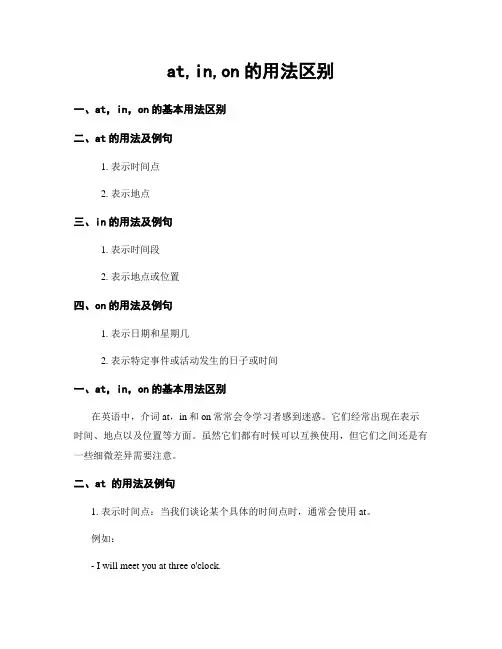
at,in,on的用法区别一、at,in,on的基本用法区别二、at的用法及例句1. 表示时间点2. 表示地点三、in的用法及例句1. 表示时间段2. 表示地点或位置四、on的用法及例句1. 表示日期和星期几2. 表示特定事件或活动发生的日子或时间一、at,in,on的基本用法区别在英语中,介词at,in和on常常会令学习者感到迷惑。
它们经常出现在表示时间、地点以及位置等方面。
虽然它们都有时候可以互换使用,但它们之间还是有一些细微差异需要注意。
二、at 的用法及例句1. 表示时间点:当我们谈论某个具体的时间点时,通常会使用 at。
例如:- I will meet you at three o'clock.(我会在三点钟与你见面)- Let's have dinner at seven tonight.(今晚七点咱们吃晚饭吧)2. 表示地点:当我们指明某个具体的地点时,也常使用 at。
例如:- He is waiting for you at the bus stop.(他正在公交车站等你)- We will meet at the coffee shop.(我们将在咖啡店碰面)三、in 的用法及例句1. 表示时间段:当我们描述一段时间、某个年月或季节时,通常会使用 in。
例如:- I usually go jogging in the morning.(我通常在早上慢跑)- We will go on vacation in July.(我们七月份去度假)2. 表示地点或位置:当我们指明某个具体的地点或用来表示在某个范围内时,常使用 in。
例如:- The cat is hiding in the wardrobe.(猫躲在衣柜里)- The book you are looking for is in the library.(你要找的书在图书馆里)四、on 的用法及例句1. 表示日期和星期几:它常与特定的日期、星期或节日相关联。
介词in,on,at用法与区别在英语中,介词是连接名词、代词或词组与其他单词之间关系的词语。
其中,in、on和at是三个常见的介词,在使用中有着明显的区别。
本文将详细介绍这三个介词的用法和区别。
1. in的用法:1. 表示位置:in通常用于表示某人或某物所在的位置,如"in the room"(在房间里)。
2. 表示领域、范围:in可用来表示某个领域或范围内的情况,比如"in science"(在科学领域)。
3. 表示时间:in可用于表示某个时间段内,在这种情况下,通常与月份、季节、年份等连用,例如"in May"(在五月)。
4. 表示交通工具:in还可用于表示乘坐交通工具的状态,如"inthe car"(在车里)。
5. 表示材料:in可用来表示某物的材料,例如"in a box made of wood"(在一个木制的盒子里)。
2. on的用法:1. 表示位置:on通常用于表示某物所在的具体位置,比如"on the table"(在桌子上)。
2. 表示表面:on可用来表示某物的表面,如"on the wall"(在墙上)。
3. 表示日期:on可用来表示具体的日期,例如"on Monday"(在星期一)。
4. 表示交通工具:on可用于表示乘坐交通工具的状态,如"on the bus"(在公交车上)。
5. 表示状态:on可用来表示某人或某物的状态,如"on fire"(着火)。
3. at的用法:1. 表示位置:at常用于表示某个具体的位置,如"at the park"(在公园里)。
2. 表示时间:at用于表示具体的时刻,例如"at 9 o'clock"(在九点)。
at, in与on的用法一、表示时间,注意以下用法:①表示时间的某一点、某一时刻或年龄等用at。
如:I get up at six in the morning、我早上六点钟起床。
He got married at the age of 25、她25 岁结婚。
②泛指一般意义的上午、下午或晚上以及月或年等较长的时间,一般用in。
如:We watch TV in the evening、我们晚上瞧电视。
He went to Japan in 1946、她于1946 去了日本。
③若表示星期几或某一特定的日期,则用on。
如:He left here on the fifth of May、她于5 月5 日离开这儿。
二、表示地点、场所、位置等,注意以下用法:①表示某一点位置,用at。
如:We live at No 87 Beijing Road、我们住在北京路87 号。
The hospital is at the end of the street、医院在这条街的尽头。
与名词所有格连用表示地点,也用at。
如:at my sister's 在我姐姐家at the doctor's 在医务室②表示空间或范围,用in。
如:What's in the box? 这盒子里有什么?He lives in Paris with his wife、她同她妻子住在巴黎。
但有时两者可换用。
如:The meeting was held at [in] the hotel、会议在宾馆举行。
③at 与in 的另一个区别就是:at 用于指较小的地方,而in 用于指较大的地方。
如:in Shanghai 在上海at the station 在车站但就是,大与小就是相对的,有时随着说话者的着眼点不同,大地方也可能用at(比如把一个大地方瞧作一个点时)。
如:Our plane refuelled at London、我们的飞机在伦敦加油。
介词in,on,at在表示时间时的区别
in 表示具体的某一天里的某个时间,还可以表示一段比较长的时间,如一个月,一季,一年,几个世纪。
如句子:We can finish this work in two weeks. 我们可以在两
周内完成此项工作。
on 一般用于具体的某一天,而且在英语口语和书面语中,它有时与in相混用。
句子:We saw her on Saturday. 我们在星期六见到了她。
at 表示具体的时间点,可以指分钟,小时,上午,晚上,半夜以及一天中的某一时刻。
如句子:We'll meet at 10:30. 我们10点半见面。
in, on, at在指时间时固然有区别,但是在具体用法上,要根据上下文具体情况使用,可以搭配不同的形容词以及副词来添加所表达的具体意思。
希望以上内容能让你有更多的
参考认识,加油!。
at,in与on的用法一、表示时间,注意以下用法:①表示时间的某一点、某一时刻或年龄等用at。
如:Igetupatsixinthemorning.我早上六点钟起床。
Hegotmarriedattheageof25.他25岁结婚。
②泛指一般意义的上午、下午或晚上以及月或年等较长的时间,一般用in。
如:WewatchTVintheevening.我们晚上看电视。
HewenttoJapanin1946.他于1946去了日本。
③若表示星期几或某一特定的日期,则用on。
如:HelefthereonthefifthofMay.他于5 月5日离开这儿。
二、表示地点、场所、位置等,注意以下用法:①表示某一点位置,用at。
如:WeliveatNo87BeijingRoad.我们住在北京路87号。
Thehospitalisattheendofthestreet.医院在这条街的尽头。
与名词所有格连用表示地点,也用at。
如:atmysister's在我姐姐家atthedoctor's在医务室②表示空间或范围,用in。
如:What'sinthebox这盒子里有什么HelivesinPariswithhiswife.他同他妻子住在巴黎。
但有时两者可换用。
如:Themeetingwasheldat[in]thehotel.会议在宾馆举行。
③at与in的另一个区别是:at用于指较小的地方,而in用于指较大的地方。
如:inShanghai在上海atthestation在车站但是,大与小是相对的,有时随着说话者的着眼点不同,大地方也可能用at(比如把一个大地方看作一个点时)。
如:OurplanerefuelledatLondon.我们的飞机在伦敦加油。
WestoppedforanhouratMoscowonourwaytoParis.我们在去巴黎的途中在莫斯科停了1个小时。
④介词on用于地点,主要指在某物的表面。
at, in与on的用法一、表示时间,注意以下用法:①表示时间的某一点、某一时刻或年龄等用at。
如:I get up at six in the morning. 我早上六点钟起床。
He got married at the age of 25. 他25 岁结婚。
②泛指一般意义的上午、下午或晚上以及月或年等较长的时间,一般用in。
如:We watch TV in the evening. 我们晚上看电视。
He went to Japan in 1946. 他于1946 去了日本。
③若表示星期几或某一特定的日期,则用on。
如:He left here on the fifth of May. 他于5 月5 日离开这儿。
二、表示地点、场所、位置等,注意以下用法:①表示某一点位置,用at。
如:We live at No 87 Beijing Road. 我们住在北京路87 号。
The hospital is at the end of the street. 医院在这条街的尽头。
与名词所有格连用表示地点,也用at。
如:at my sister's 在我姐姐家at the doctor's 在医务室②表示空间或范围,用in。
如:What's in the box? 这盒子里有什么?He lives in Paris with his wife. 他同他妻子住在巴黎。
但有时两者可换用。
如:The meeting was held at [in] the hotel. 会议在宾馆举行。
③at 与in 的另一个区别是:at 用于指较小的地方,而in 用于指较大的地方。
如:in Shanghai 在上海at the station 在车站但是,大与小是相对的,有时随着说话者的着眼点不同,大地方也可能用at (比如把一个大地方看作一个点时)。
如:Our plane refuelled at London. 我们的飞机在伦敦加油。
⑴时间或地点介词in、on、at的用法区别:表示时间时, in表示在一段时间里(在将来时句子中则表示在一段时间之后), on表示在具体的某一天或者某天的上下午等, at表示在某个时刻或者瞬间;表示地点时, in表示在某个范围之内, on表示在某个平面上或与一个面相接触,at则表示在某个具体的场所或地点。
如:He was born on the morning of May 10th.(他出生于五月十日的早晨)/ I usually get up at 7:00 in the morning.(我通常在早上的七点钟起床) / His glasses are right on his nose.(他的眼镜就架在他的鼻子上)/ He is at the cinema at the moment.(此刻他正在电影院)⑵after与in表示时间的用法区别:“after+(具体时刻/从句)”表示“在…时刻之后”常用于一般时态;“in+(一段时间)”表示“在(多久) 之后”,常用于将来时态。
如:He said that he would be here after 6:00.(他说他六点钟之后会来这儿)/ My father is coming back from England in about a month.(我父亲大约一个月以后从英国回来)⑶since与for表示时间的用法区别:“since+(具体时刻/that-从句)”表示“自从…起一直到现在”,“for +(一段斶间)”表示“总共有…之久”,都常用于完成时态;如:Uncle Li has worked in this factory since 1970.(李叔叔自从1970年起就在这家工厂工作了)/ Uncle Li has worked in this factory for over 30 years. (李叔叔在这家工厂已经工作了30多年)⑷by、in与with表示方式的用法区别:都可以表示“工具、手段”,但是by主要表示“乘坐”某个交通工具或“以……方式”,在被动句中可以表示动作的执行者;in表示“使用”某种语言/文字,with表示“使用”某个具体的工具、手段。